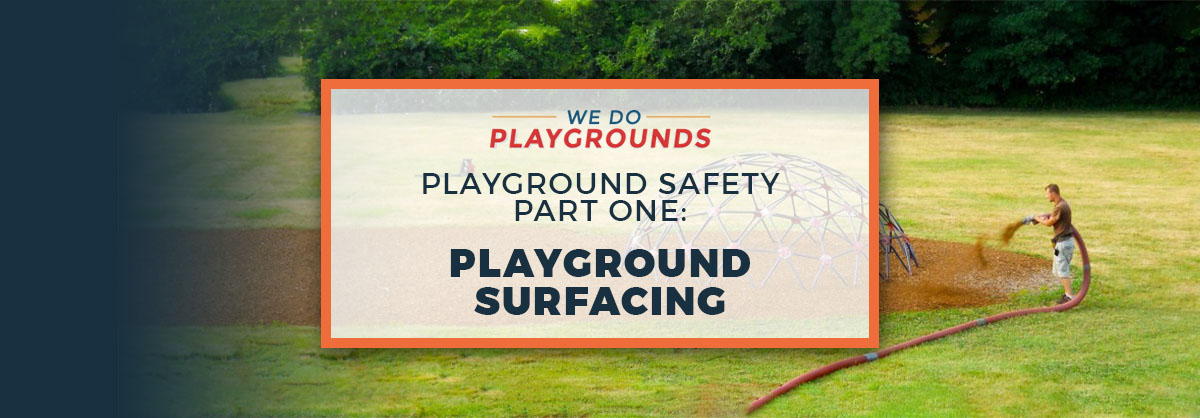 Adding a playground increases your property’s ability to be family-friendly, and attract a larger community to your area. When it comes to building a playground structure for your business, organization, or community, safety should be your top priority, and should be considered from the very beginning of the design process. That being said, the surface of your playground has much more influence on the safety of your playground than you’d think. J.C. Walker & Sons is Michigan’s leading playground equipment safety experts. In this blog series, we’ll be outlining tips and considerations for how to build the safest playground possible for your community. In this blog, we’re starting from the bottom with the surface of your playground and the safety considerations when it comes to choosing the right surfacing material for you.
Adding a playground increases your property’s ability to be family-friendly, and attract a larger community to your area. When it comes to building a playground structure for your business, organization, or community, safety should be your top priority, and should be considered from the very beginning of the design process. That being said, the surface of your playground has much more influence on the safety of your playground than you’d think. J.C. Walker & Sons is Michigan’s leading playground equipment safety experts. In this blog series, we’ll be outlining tips and considerations for how to build the safest playground possible for your community. In this blog, we’re starting from the bottom with the surface of your playground and the safety considerations when it comes to choosing the right surfacing material for you.
How does playground surfacing relate to safety?
The surface of your playground is more important to the safety of those who play on your playground than you may think. It is what children will land on when they come flying out of a slide, decide to jump off of the swings, or fall from the monkey bars. It’s important to make sure that if a child is landing on your playground’s surface, that the surface provides a sturdy cushion to prevent injury. When designing your playground, make sure the play area surface is significantly larger than the actual play structure. This is to make sure that there is plenty of room for a safe landing after jumping off platforms, slides, or swings. In addition, it’s important to enclose and define the play space with a border. This keeps the ground cover where it belongs, and ensures that the play area goes with the overall landscape design.
What kind of surface should I use?
When choosing a ground cover, you want to make sure it’s safe, low maintenance, attractive, and affordable. When designing your playground, you should decide which color mulch you need. The mulches that aren’t dyed will fade quicker than color-enhanced mulches, and will require replacement sooner. When it comes to surface options, the most common options are:
- Shredded Rubber Mulch: Shredded mulch is a popular option because it provides a cushion when children fall. It is a springy material, which also acts as a weed barrier. It is generally low maintenance, however it gets dirty after long-term use. It’s the most likely to escape the play area border and stick to children’s shoes, tracking into schools and homes. This is a great option for those looking for mostly low-maintenance surfacing, that provides a soft place for children to fall.
- Solid Rubber And Rubber Tiles:Â Solid rubber playground surfaces are most common in neighborhood parks and school playgrounds. Rubber tiles and poured rubber surfaces are level, slip resistant, and drain well. They also provide an easily accessible surface for wheelchairs or strollers, and are available in a variety of thicknesses to meet a variety of different needs. Although this option tends to be more pricey, it is easy to maintain and considered one of the safest playground surfaces.
- Play Sand: Play sand has been the ground cover of choice for a long time due to its affordability and ability to absorb falls. When using sand, it should be noted that it’s important to provide enough sand to provide a cushion. Shallow sand does not provide good protection when landing. It’s important when choosing this option to provide about one foot of sand evenly spread across the play area surface. Sand is a bit more high maintenance than other options because it shifts often. Due to the frequency of shifting, it’s important to regularly check the depth and replenish the areas that become too shallow. When purchasing sand, make sure it is approved to be used for a playground and does not contain harmful materials.
- Wood chips: Wood chips are not as common as sand or rubber surfacing options. There are specific types of wood mulch that are used for playgrounds because they compact the wood chips to provide a softer cushion for landing and less of a choking hazard. Wood chips aren’t always recommended due to the fact that they can hide hazards (like broken glass) and be prone to mold or splinters. However, this surfacing option is more budget-friendly, and is easily replaced. When choosing wood chips for the surface of your playground, be sure to make sure there aren’t any added dyes or unnecessary chemicals.
With J.C. Walker & Sons, we provide playground surfacing that conforms to Michigan state regulations. We efficiently and safely install your playground surfacing. Contact us today to learn more about our playground mulch installation services.

